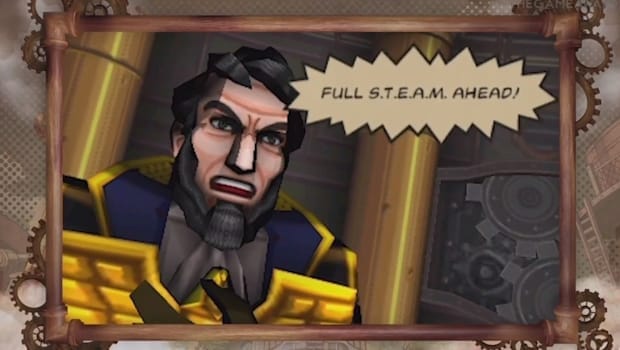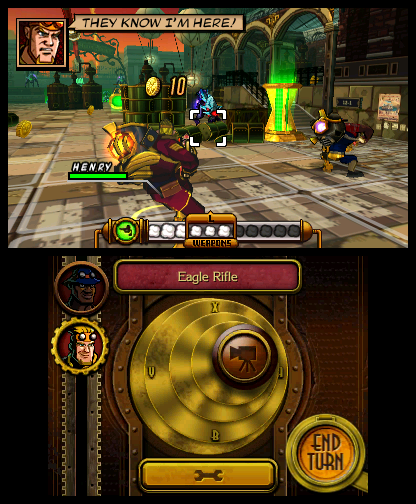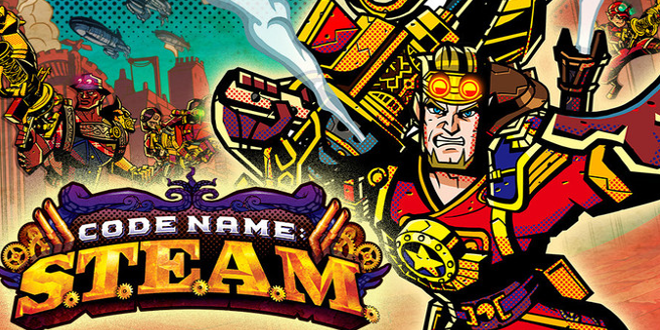Former President Abraham Lincoln, after supposedly faking his assassination in 1865, begins a clandestine shadow organization with cutting edge technology to combat any threats that would impose the ideals he would stand for. In turn, alien beings begin to suddenly attack a steampunk London, which has Lincoln lead a ragtag team of literary characters, folklore heroes, and a giant steam powered robot of himself against the alien menace.
If the premise is as ludicrous as it sounds, that's because it makes the League of Extraordinary Gentlemen blush at the gregariousness of it's purpose. Yet that is the backdrop behind Codename S.T.E.A.M, a 3DS strategy title by Nintendo’s own Intelligent Systems. With the pedigree of the studio behind Fire Emblem and Advanced Wars, Codename S.T.E.A.M is in good company as a new take on the strategy genre.
At least, in theory. In practice, Codename S.T.E.A.M is a tough pill to swallow, offering a perplexing blend of questionable design choices wrapped into a relatively solid package. By no means a bad game, Codename S.T.E.A.M is severely hampered by several design flaws that really hold it back from being great.
Intelligent Systems, already well known for other strategy titles, opted to go all out in making something new. Abandoning the 2-D artwork and a top-down overhead design, Codename S.T.E.A.M offers a fully 3-D, over the shoulder 3rd person perspective, akin to Sega’s Valkyria Chronicles. That is where the similarities end, however, as Codename S.T.E.A.M is pure strategy, eschewing any form of a level up system or character progression element that has accompanied such titles in the past.

In it’s place, we have full 360 degree camera controls, and a 3-D world without any form of mini-map or perspective change. The only things you see are what your four person team can see; a sometimes frustrating experience that would no doubt upset the micromanagers out there. With your eyes cut off from the entire battlefield, formulating plans well ahead of the enemy is now more difficult, in what is an already difficult title.
Codename S.T.E.A.M does not put on the kid gloves either. Right from the get-go, as mechanics are introduced to the game, you are outnumbered and on the defensive against a variety of alien unit types. Movement and coordination are key to surviving the onslaught, as is resource management. Each of your agents has two statistics, health and steam power, that you need to manage as you press forward on a given map. Steam power is used to both attack enemies head on with your weapons, or to overwatch, essentially taking a turn during the enemy phase to interrupt their movement and potentially stun or kill them. Since movement and using weapons cost steam, players need to weigh the pros and cons of their next actions carefully. Do you move to a better position but keep yourself vulnerable without any steam power, or do you cover a flank at all costs while your squad circles around the enemy?
These kind of snap decisions are where Codename S.T.E.A.M really shines; without full knowledge of what the enemy is doing or even sight of the whole battlefield, each skirmish is a fight that feels well earned once you beat it. To conquer an onslaught of enemies without losing a squad mate, executing tactics and taking calculated risks when you have to is it’s own reward. Tactics learned from one mission apply to all missions as well; sneaking, for example, is paramount to success in some cases when particularly vicious enemies only move and attack by sound, allowing you to better position yourselves or bypass them all together if you wish. Throw in a variety of missions, from escorts to rescues to controlling mecha Abe Lincoln against giant alien monsters, and your tactics change each time depending on the given situation.
Unfortunately, the biggest hairline fracture comes from the tedium behind this. While enemies are often difficult to keep down and outnumber you immensely, it is their own turn of movement that becomes the games Achilles heel. The alien movement turns can clock upwards of over a minute in real time, a minute where you simply stare at a zoomed in portion of the battlefield through the perspective of one of your squad members. Nothing you press effects the turn, even overwatch attacks are done automatically here. It is simply a waiting game for it to complete, a waiting game that extends the sometimes ten-plus rounds of combat you have to go through just to finish a standard level.

If there was ever a case for skipping a turn, this is it. Almost all the goodwill bought by the tactical play itself is nearly erased in an instant by the sheer boredom that is built into the game. It makes Codename S.T.E.A.M more of a chore to play in long sittings than it should, making it a game ideal for short spurts. To be fair, that should be the proper use of a handheld title, however as a strategy game its very uncommon to demand short sessions out of your players. Even the multiplayer versus mode, which was almost completely barren of anyone attempting it, had the same issues of long turns, although limits were put on their deathmatch mode at the very least.
And what is the grand reward for sticking it out? For the campaign mode it is continuous progression through various maps and scenarios with unlocked squad mates, as well as challenge modes that remove different features for your team, such as blind-eye which eliminates the entire HUD for you completely. All of this is done to earn more medals and gears on a map to unlock more steam boilers and secondary weapons. There is little incentive, other than the self satisfaction of defeating the really good AI, to replay a map outside of grinding out for a higher score and quicker access to weapon unlocks.
Even the storyline itself, as unique as it can be, falls flat in terms of any sensible plotline, although that is mostly by design. Instead of offering a semi-serious, melodramatic soap opera like the stories found in the Fire Emblem series, Codename S.T.E.A.M goes for the comic-book style route, big characters, big premise, little development in-between. The mere fact that the likes of the Cowardly Lion, Queequeg and Randolph Carter are fighting off aliens is a pure comic book pastiche, a silver age throwback that is visually striking at the very least.
The game, however, rarely takes itself seriously, constantly winking at the audience how unrealistic the entire scenario is. The aesthetics are steampunk in name only, using the theme instead of the philosophical ideals behind the genre to a stylistic affect, with thick, black outlines and cel-shading to really ramp up the comic feel. The music and voice acting are in on the joke, purposely hamming up the line deliveries by the likes of Wil Wheaton and Adam Baldwin to add to the pulpyness of the game. Even the paltry amiibo support, where you can import Fire Emblem characters into the game, makes about as much sense as mecha Abe Lincoln and feels like a marketing afterthought over a meaningful bonus.
https://www.youtube.com/watch?v=HpcTwOHXdqw
Many may feel disappointed by the lack of actual character development, but Codename S.T.E.A.M also doesn’t really need to develop a concise narrative. As a fun diversion, Codename S.T.E.A.M has the style it needs to be visually striking and wholly unique in a Nintendo sort of way. You can forgive the design a lot because it is something unique, and not just another kitschy color palette.
Yet Codename S.T.E.A.M lacks a certain substance to really have lasting impact. In truth, I can see Codename S.T.E.A.M becoming somewhat of a guilty pleasure in the future; the challenge is there and it has just enough complexity to be engaging, but the game is paralyzed by stretches of tedium and frustration, the two key ingredients that destroy strategy games on the whole. It is a tough sell to make a strategy game all about pure strategy where the style of the game feels like a near afterthought to justify the mechanics used. Even tougher still when it has some questionable mechanical choices thrown in for good measure.
By no means a bad game in the end, Codename S.T.E.A.M can barely carve out a niche for itself despite how stylish it looks. Underneath all that comical, jingoistic bluster is a pretty good strategy game with some pretty serious design flaws; flaws that make the title fun in the short term, but by the midway point it feels like it’s running out of steam.
Codename S.T.E.A.M was purchased by this reviewer for the Nintendo 3DS.
Review Summary
By no means a bad game in the end, Codename S.T.E.A.M has good design choices hampered by lots of tedium and frustration.
(Review Policy)Have a tip, or want to point out something we missed? Leave a Comment or e-mail us at tips@techraptor.net













